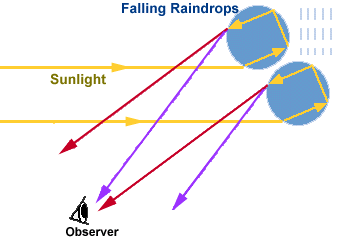|
|
. |
Secondary Rainbows
fainter than a primary rainbow
A secondary rainbow
appears outside of a
primary rainbow
and develops when light entering a raindrop undergoes two
internal reflections instead of just one (as
is the case with a primary rainbow).
The intensity of light is reduced even further by the second reflection, so
secondary rainbows are not as bright as primary rainbows.
Alternatively: fewer light rays go through the four-step
sequence than the three-step sequence.
[Image: a secondary rainbow (43K)]
Photograph by:
Olthoff
The color scheme of the secondary rainbow
is opposite of the primary rainbow.
Violet light from the higher
drop enters the observer's eye,
while red light from the same drop is incident
elsewhere.

Simultaneously, red light from the lower drop
enters the observer's eye and violet light is not seen.
This is why the colors of a secondary rainbow change from violet on the
top to red on the bottom.

primary rainbow
|
|

Midlatitude Cyclones
|
|


